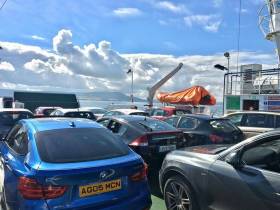Displaying items by tag: Scenic Ferries
Scenic Ulster: Ferries Part of Ireland’s Largest Domestic Operator
#ferry –This summer saw the much awaited launch of Scenic Carlingford Lough service, however the Limerick based owners introduced another ferry in Ulster this season, writes Jehan Ashmore.
To recap firstly is the new historic first Carlingford service which saw operator, Frazer Ferries Group began sailings in July. The route is operated by the 44 vehicle ferry, Frazer Aisling Gabrielle plying the lough between Greenore, Co. Louth and Greencastle, Co. Down.
Originally the launch of Scenic Carlingford Ferry was to have taken place in June, however there were delays due several reasons, among them installation of bespoke navigational aids. On installation of these bouys, the former Shannon Ferries serving vessel and Lough Foyle ferry could finally begin crossings in July. The crossing of Carlingford Lough taking only 15 minutes.
The use of ‘Scenic’ as a trading prefix along with its the Lough Foyle counterpart is part of the corporate branding exercise by Frazer Ferries. By coincidence, Scenic Lough Foyle ferry also operates out of another Greencastle, but in Co. Donegal and connecting Magilligan Point in Co. Derry.
Formerly operating this route was Foyle Venture (of previous owners) which was transferred to the new Carlingford operation and renamed Frazer Gabrielle Aisling. In turn taking place on the Foyle route this summer was the newly introduced Frazer Mariner. This smaller ferry had served a career in Germany.
Both Ulster services save on mileage providing a short-cut for local motorists. In addition providing options for visitors to take touring routes and boost local economies.
Frazer Ferries are the largest operators of domestic services on the island of Ireland as last year the ferry firm acquired the business Passage East Ferry Company established in the 1980’s.
The ferry, F.B.D. Tintarn part of the previous outfit, continues to ply the waters in lower Waterford Estuary. This south-east link connects Passage East in Co. Waterford with Ballyhack in Co. Wexford. This route providing a commuter route for those working in Waterford in addition to a tourist short-cut.
Unlike the northern ferry routes, the southern service continues to retain its former trading name along with the ferry.























